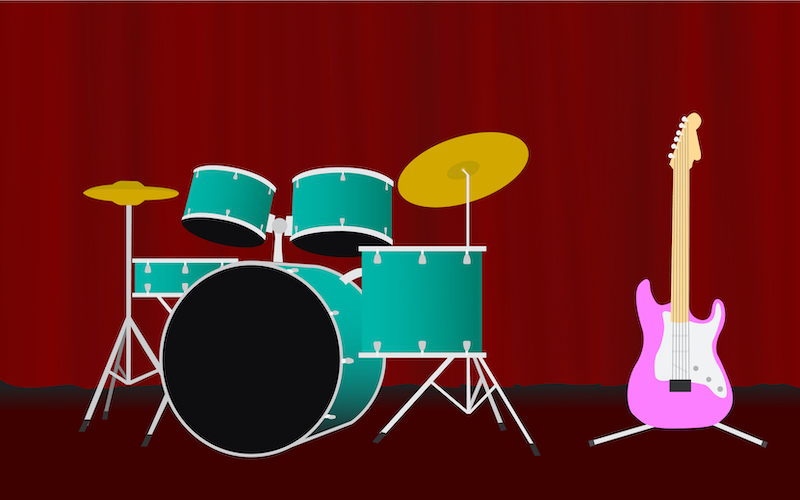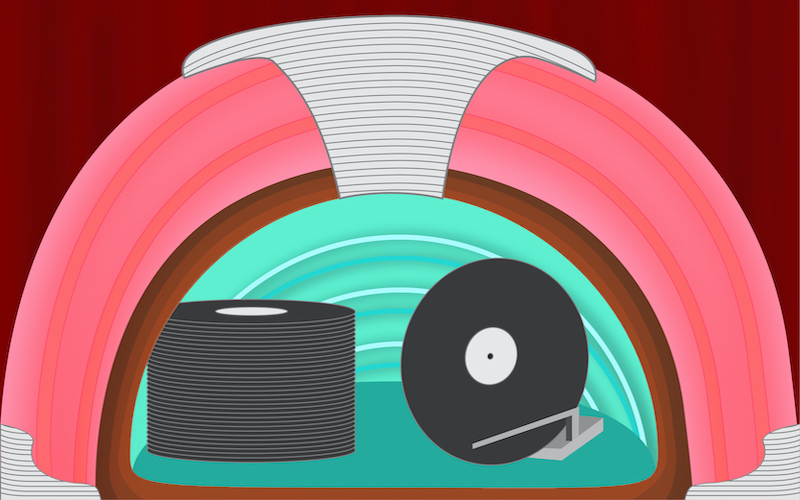Usually, when you listen to rock songs, and especially ones from the ’50s, there’s a pretty clear narrative. The lyrics offer a sense of the narrator’s relationship to the subject at hand. We all know (or can at least imagine) the drama involved in, for example, Elvis’s “Return to Sender” or Chuck Berry’s “Memphis.” The concise writing and the vocals’ knowing narration vividly demonstrates how an entire dramatic arc can be laid out in less than three minutes, with the usual verse/chorus/verse song structure that subtly cues up the audience’s responses, giving the melody a foundation during the verses and getting us all ready to sing along with the chorus.
If the listener isn’t provided with an explicit narrative to follow, we can imagine a particular narrator’s physical characteristics: something as simple as eyes, hair, or an item of clothing can be the basis of a whole character sketch. Freda Payne’s “Band of Gold” and Nina Simone’s “Plain Gold Ring” use the exact same piece of jewelry to tell quite different stories about the complex relationships involved. The narrator is using these details to provide necessary information about their own identity, or they might be describing a specific situation, but either way, the listener is usually guided through a coherent story already in progress. Chuck Berry, for one, knew perfectly well what his audiences wanted and gave them immaculately crafted tunes about fast cars, boring school days, and the joys and sorrows of relationships.
But there are some songs that break this mold completely and Buddy Holly’s feral “Peggy Sue” is one of them. It serves as a case in point of how one of the founding fathers of rock ‘n’ roll willfully broke all of the established structural and narrative rules about how a rock ‘n’ roll song should be written and made it a memorably unconventional hit out of it. Brilliantly ambiguous, idiosyncratic, slightly mad and subtly perverse, “Peggy Sue” is one of the greatest songs of all time, in any genre: it’s thoroughly if unintentionally Modernist, a kind of cubist painting in words and sound.
The title of “Peggy Sue” came from a playful, spontaneous mashup of the names of some people Holly knew, such as his drummer’s then-estranged girlfriend Cindy Lou, who died not long ago. And maybe there’s a little something to the spontaneous quality of the song, while we’re at it: according to Little Richard’s hilariously frank authorized biography (and does anyone really think Little Richard, of all people, ever lies about anything?), Holly could be, let’s just say, improvisational when it came to matters of Eros and leave it at that. Like that the slick wordsmith Chuck Berry, the self-mythologizing Bo Diddley, or the Dionysian Elvis Presley, Buddy Holly knew how to get his music across. Holly was able to present a boyish image, with those coke bottle glasses and curly hair, while maintaining the street cred that comes with writing bangers like “Rave On” and covering Bo Diddley’s namesake tune and Little Richard’s raucous “Ready Teddy” with all the intensity you could ask for.
The eponymous Peggy is constantly referred to but goes almost totally undescribed in any real way, remaining an obscure object of desire. The narrator starts by claiming that if you knew her like he does, you’d miss her as much as he does, which isn’t really explaining very much at all. Then he tells Peggy (or his idea of Peggy) that he loves her, oh yes he does, his heart yearns for her, just like in every corny Hallmark Valentine’s card ever inscribed to the most innocuous American name of all time. On the surface, this is merely another sugary pop ditty, but if we listen more closely that saccharine coating slowly dissolves into a shot of hard sweet liquor.

We are told that she’s “pretty” (which is a fairly predictable trait for women in ’50’s rock and roll songs sung by men) but it’s not just that: the narrator informs us that Peggy’s actually “prettyprettyprettypretty.” That’s no less than four emphatic “pretties” in one repeated line, which changes the stakes considerably. It’s insistent, adamant, even a little neurotic. Contrary to most ’50’s era rock songs, there isn’t any information offered about who Peggy is or what she specifically looks like or her relationship to the infatuated narrator; instead, we are emphatically told that she’s prettyprettyprettypretty, which has more to do with the narrator explaining her entirely on his own terms rather than anything to do with her. In some sense, “Peggy Sue” is a song about wanting something quite badly but not knowing what to do with it if you ever got it, a teenage dilemma if there ever was one. In some ways, it might even be a #MeToo song: how would you feel if a guy started singing this song to you, stuttering and stammering his way through telling you that he wants you and he needs you, and repeating your name over and over again?
Consider the beat: it’s all primal Bo Diddley rumble, which in the repressed, conformist Eisenhower era signified raw sexuality. And that steady thumping is accentuated by the slashing of two surging and edgy chords that will prefigure the shape of punk rock to come. A jolt of nervous energy buzzes throughout that minimalist rhythm section. And think of the off-kilter tone of the high-pitched vocal, with Holly’s trademark hiccup accentuations and his unique scat-like riffing off of the extremely basic, almost plainspoken main theme. Sometimes he sounds cocksure, like a greaser stud out on the prowl, but at other times he sounds infantile, particularly in the fourth verse, where he coos like a baby splashing in a bathtub. What exactly is the narrator doing in this song? Do we know? Do we even want to know?
It might be my English major mentality kicking in, but the way I hear it “Peggy Sue” is a prime example of rock lyrics as Modernist poetry. Considering the sing-song repetition of that recognizable name, “Peggy Sue” is an avant-garde language experiment that sounds like something out of Joyce or Gertrude Stein (cf. “a rose is a rose is a rose is a rose”). In Holly’s radical twist on a pop song’s expectations, the titular name loses all stable meanings and becomes sheer sound, a concept that fascinated the Modernists poets. There’s no attempt at a narrative, no characterization, no climax, nothing. Just the eponymous Peggy, or at least her image, and how prettyprettyprettypretty she apparently is. But of course, that lack of information means she’s not like any real Peggy that’s ever actually existed, and here’s where things start to get weird.
The speaker’s monomania is actually a little disturbing if you think about it. It’s obsessive, neurotic, compulsive: it says I want, I want, I want. The desire is perverse not because it seeks to do something necessarily obscene, thought that insistent beat may suggest otherwise, but because it doesn’t really have a specific goal. Whatever the situation the narrator of “Peggy Sue” is in, he’s definitely not in control of it. To borrow a phrase from Picasso, he hasn’t caught desire by the tail, it’s more like the other way around. He sounds like Lenny in Of Mice and Men or Dennis Hopper’s neurotic psycho in Blue Velvet. David Lynch has always been particularly adept at delving below the surface innocence of classic Americana into the more surreal, demented elements lurking underneath. Buddy Holly’s curly-headed, skinny, and bespectacled boy next door earnestness wasn’t exactly a put on; his biography seems to show him to be quite a decent chap. But even though he had that family-friendly image, Holly was a born rock ‘n’ roller from West Texas who knew his way around a party. Appearances can be deceptive, especially in rock and roll.

To be clear, I’m not accusing Buddy Holly of anything morally untoward — it’s usually better to trust the tale, and not the teller, which is why I’ve been referring to “the narrator” of the song and not Holly himself. Holly was always much more musically inventive than he is usually given credit for: he endlessly experimented with studio effects, occasionally added orchestration, and turned a phrase growled by John Wayne in The Searchers — “that’ll be the day” — into another one of his classic hits.
Only a master songwriter can put out an avant-garde and slightly demented version of a typical ’50s rock song, one that combines Modernist wordplay with Bo Diddley’s iconic beat and also happens to check off several of the boxes in William Empson’s famed seven types of ambiguity. With “Peggy Sue” Holly split the atom of the radio-friendly rock and roll that was then beginning to take over the world. And if you’re still not convinced that “Peggy Sue” is crazier than it might sound at first, consider it a trailblazer for the kind of popular music that turns out to be far less innocent the more closely you listen.
The Beatles’ hair-raising “Run For Your Life” and the sinister “Doctor Robert” match with The Police’s paranoid “Every Breath You Take” and the Nabokovian “Don’t Stand So Close To Me” by hiding their disturbing themes under their catchy melodies. Joe Cocker’s “Feelin’ Alright” and The Statler Brothers’ “Flowers on the Wall” portray fairly manic mindsets underneath all the surface jauntiness. More contemporary examples might be Foster The People’s menacing “Pumped Up Kicks” and Drake and Kanye’s forlorn broodings over their various romantic and/or existential dilemmas. The crackling ambiguities Buddy Holly built into “Peggy Sue” all those decades ago presaged all of these and proves that sometimes the true depths of pop music aren’t always immediately apparent at first listen.•




